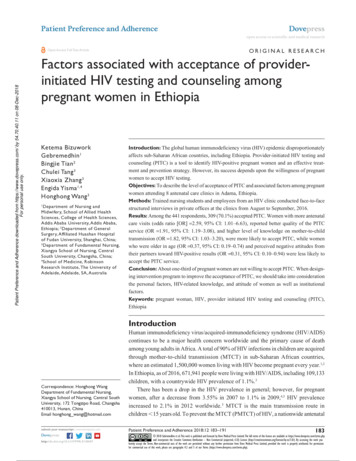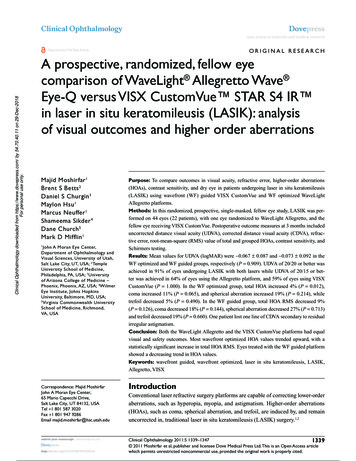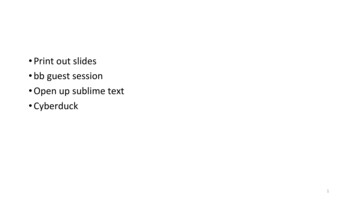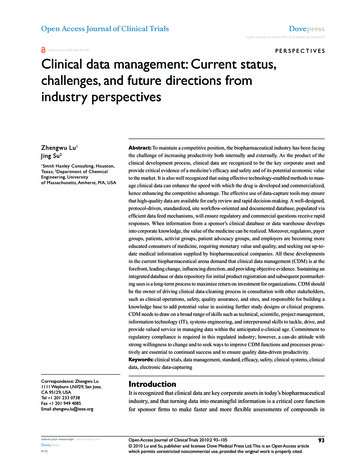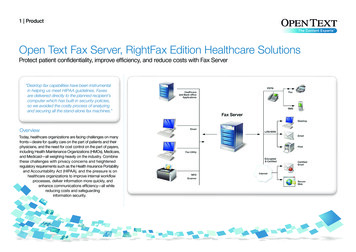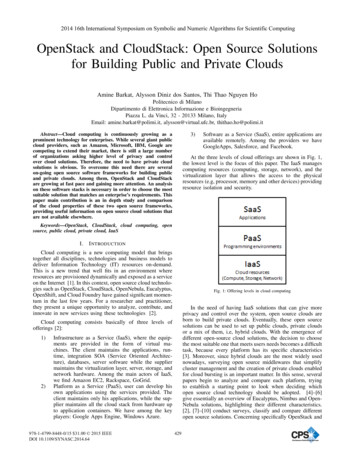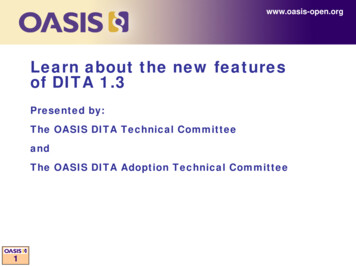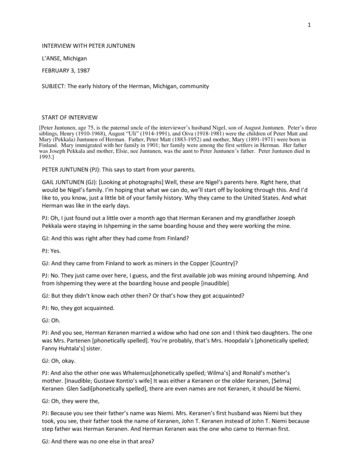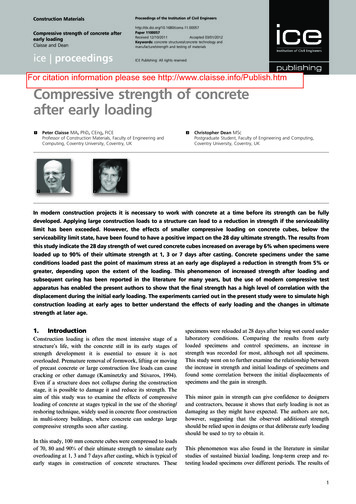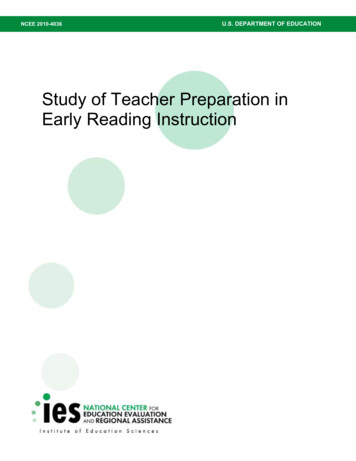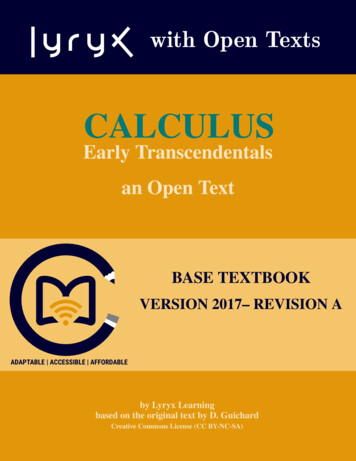
Transcription
with Open TextsCALCULUSEarly Transcendentalsan Open TextBASE TEXTBOOKVERSION 2017– REVISION AADAPTABLE ACCESSIBLE AFFORDABLEby Lyryx Learningbased on the original text by D. GuichardCreative Commons License (CC BY-NC-SA)
a dv a ncin gl ea rn i n gChampions of Access to KnowledgeONLINEASSESSMENTOPEN TEXTAll digital forms of access to our high-qualityopen texts are entirely FREE! All content isreviewed for excellence and is wholly adaptable; custom editions are produced by Lyryxfor those adopting Lyryx assessment. Accessto the original source files is also open to anyone!We have been developing superior online formative assessment for more than 15 years. Ourquestions are continuously adapted with thecontent and reviewed for quality and soundpedagogy. To enhance learning, students receive immediate personalized feedback. Student grade reports and performance statisticsare also provided.INSTRUCTORSUPPLEMENTSSUPPORTAccess to our in-house support team is available 7 days/week to provide prompt resolutionto both student and instructor inquiries. In addition, we work one-on-one with instructors toprovide a comprehensive system, customizedfor their course. This can include adapting thetext, managing multiple sections, and more!Additional instructor resources are also freelyaccessible. Product dependent, these supplements include: full sets of adaptable slides andlecture notes, solutions manuals, and multiplechoice question banks with an exam buildingtool.Contact Lyryx Today!info@lyryx.com
a dv a ncin gl ea rn i n gCalculus – Early Transcendentalsan Open TextBE A CHAMPION OF OER!Contribute suggestions for improvements, new content, or errata:A new topicA new exampleAn interesting new questionA new or better proof to an existing theoremAny other suggestions to improve the materialContact Lyryx at info@lyryx.com with your ideas.CONTRIBUTIONSJim Bailey, College of the RockiesMark Blenkinsop, Carleton UniversityMichael Cavers, University of CalgaryDavid Guichard, Whitman CollegeAPEX Calculus: Gregory Hartman, Virginia Military InstituteJoseph Ling, University of CalgaryLyryx Learning TeamBruce BauslaughPeter ChowNathan FriessStephanie KeyowskiClaude LaflammeMartha LaflammeJennifer MacKenzieTamsyn MurnaghanBogdan SavaLarissa StoneRyan YeeEhsun ZahediLICENSECreative Commons License (CC BY-NC-SA): This text, including the art and illustrations, are availableunder the Creative Commons license (CC BY-NC-SA), allowing anyone to reuse, revise, remix andredistribute the text.To view a copy of this license, visit http://creativecommons.org/licenses/by-nc-sa/3.0/
a dv a ncin gl ea rn i n gCalculus – Early Transcendentalsan Open TextBase Text Revision HistoryCurrent Revision: Version 2017 — Revision AExtensive edits, additions, and revisions have been completed by the editorial team at Lyryx Learning.All new content (text and images) is released under the same license as noted above. Lyryx: Front matter has been updated including cover page, copyright, and revision pages.2017 A Lyryx: Examples 15.6, 16.11, 16.13, 16.3, 15.10, 16.20 and Exercises 15.4.3, 15.5.1, 16.6.1 have beenrewritten. Several exercises from Vector Calculus have been removed. Lyryx: Order and name of topics in Chapter 15 and Chapter 16 have been revised. D. Guichard: New content developed for the Three Dimensions, Vector Functions, and Vector Calculus chapters. Lyryx: Exercise numbering has been updated to restart with each section.2016 B2016 A G. Hartman: New content on Riemann Sums is included, Section 6.1.1. This section was adaptedby Lyryx from the section of the same name in APEX Calculus, Version 3.0, written by G. Hartman. T. Siemers and D. Chalishajar of the Virginia Military Instititue and B. Heinold of MountSaint Mary’s University also contributed to APEX Calculus. This material is released under CreativeCommons license CC BY-NC (https://creativecommons.org/licenses/by-nc/4.0/ ). Seehttp://www.apexcalculus.com/ for more information and original version. Lyryx: The layout and appearance of the text has been updated, including the title page and newlydesigned back cover. J. Ling: Addition of new exercises and proofs throughout.2015 A J. Ling: Revised arrangement of topics in the Application of Derivatives chapter. J. Ling: Continuity section has been revised to include additional explanations of content and additional examples. M. Cavers: Addition of new material and images particularly in the Review chapter.2014 A2012 A M. Blenkinsop: Addition of content including Linear and Higher Order Approximations section. Original text by D. Guichard of Whitman College, the single variable material is a modification and expansion of notes written and released by N. Koblitz of the University of Washington. That version also contains exercises and examples from Elementary Calculus: AnApproach Using Infinitesimals, written by H. J. Keisler of the University of Wisconsin under a Creative Commons license (see http://www.math.wisc.edu/ keisler/calc.html).A. Schueller, B. Balof, and M. Wills all of Whitman College, have also contributed content.This material is released under the Creative Commons Attribution-NonCommercialShareAlike License ).Seehttp://communitycalculus.org for more information.
ContentsContentsiiiIntroduction11 Review1.1 Algebra . . . . . . . . . . . . . . . . . . . . . . . . . . . .1.1.1 Sets and Number Systems . . . . . . . . . . . . . .1.1.2 Law of Exponents . . . . . . . . . . . . . . . . . .1.1.3 The Quadratic Formula and Completing the Square .1.1.4 Inequalities, Intervals and Solving Basic Inequalities1.1.5 The Absolute Value . . . . . . . . . . . . . . . . . .1.1.6 Solving Inequalities that Contain Absolute Values . .1.2 Analytic Geometry . . . . . . . . . . . . . . . . . . . . . .1.2.1 Lines . . . . . . . . . . . . . . . . . . . . . . . . .1.2.2 Distance between Two Points and Midpoints . . . .1.2.3 Conics . . . . . . . . . . . . . . . . . . . . . . . .1.3 Trigonometry . . . . . . . . . . . . . . . . . . . . . . . . .1.3.1 Angles and Sectors of Circles . . . . . . . . . . . .1.3.2 Trigonometric Functions . . . . . . . . . . . . . . .1.3.3 Computing Exact Trigonometric Ratios . . . . . . .1.3.4 Graphs of Trigonometric Functions . . . . . . . . .1.3.5 Trigonometric Identities . . . . . . . . . . . . . . .1.4 Additional Exercises . . . . . . . . . . . . . . . . . . . . .2 Functions2.1 What is a Function? . . . . . . . .2.2 Transformations and Compositions2.2.1 Transformations . . . . .2.2.2 Combining Two Functions2.3 Exponential Functions . . . . . .2.4 Inverse Functions . . . . . . . . .2.5 Logarithms . . . . . . . . . . . .2.6 Inverse Trigonometric Functions 576063
ivContents2.72.8Hyperbolic Functions . . . . . . . . . . . . . . . . . . . . . . . . . . . . . . . . . . . . . 68Additional Exercises . . . . . . . . . . . . . . . . . . . . . . . . . . . . . . . . . . . . . 723 Limits3.1 The Limit . . . . . . . . . . . . . . . . . . . . . . . .3.2 Precise Definition of a Limit . . . . . . . . . . . . . .3.3 Computing Limits: Graphically . . . . . . . . . . . . .3.4 Computing Limits: Algebraically . . . . . . . . . . . .3.5 Infinite Limits and Limits at Infinity . . . . . . . . . .3.5.1 Vertical Asymptotes . . . . . . . . . . . . . .3.5.2 Horizontal Asymptotes . . . . . . . . . . . . .3.5.3 Slant Asymptotes . . . . . . . . . . . . . . . .3.5.4 End Behaviour and Comparative Growth Rates3.6 A Trigonometric Limit . . . . . . . . . . . . . . . . .3.7 Continuity . . . . . . . . . . . . . . . . . . . . . . . .4 Derivatives4.1 The Rate of Change of a Function . . . . . . . . . . .4.2 The Derivative Function . . . . . . . . . . . . . . . .4.2.1 Differentiable . . . . . . . . . . . . . . . . . .4.2.2 Second and Other Derivatives . . . . . . . . .4.2.3 Velocities . . . . . . . . . . . . . . . . . . . .4.3 Derivative Rules . . . . . . . . . . . . . . . . . . . . .4.4 Derivative Rules for Trigonometric Functions . . . . .4.5 The Chain Rule . . . . . . . . . . . . . . . . . . . . .4.6 Derivatives of Exponential & Logarithmic Functions .4.7 Implicit Differentiation . . . . . . . . . . . . . . . . .4.8 Derivatives of Inverse Functions . . . . . . . . . . . .4.8.1 Derivatives of Inverse Trigonometric Functions4.9 Additional Exercises . . . . . . . . . . . . . . . . . .5 Applications of Derivatives5.1 Related Rates . . . . . . . . . . . . . . .5.2 Extrema of a Function . . . . . . . . . .5.2.1 Local Extrema . . . . . . . . . .5.2.2 Absolute Extrema . . . . . . . . .5.3 The Mean Value Theorem . . . . . . . .5.4 Linear and Higher Order Approximations5.4.1 Linear Approximations . . . . . 5137142148156157159.163163169169174178184184
Contents5.55.65.75.4.2 Differentials . . . . . . . . . . . . . . . . . . . . . . . . .5.4.3 Taylor Polynomials . . . . . . . . . . . . . . . . . . . . . .5.4.4 Newton’s Method . . . . . . . . . . . . . . . . . . . . . . .L’Hôpital’s Rule . . . . . . . . . . . . . . . . . . . . . . . . . . . .Curve Sketching . . . . . . . . . . . . . . . . . . . . . . . . . . . .5.6.1 Intervals of Increase/Decrease, and the First Derivative Test5.6.2 The Second Derivative Test . . . . . . . . . . . . . . . . .5.6.3 Concavity and Inflection Points . . . . . . . . . . . . . . .5.6.4 Asymptotes and Other Things to Look For . . . . . . . . .5.6.5 Summary of Curve Sketching . . . . . . . . . . . . . . . .Optimization Problems . . . . . . . . . . . . . . . . . . . . . . . .6 Integration6.1 Displacement and Area . . . . . . . . .6.1.1 Riemann Sums . . . . . . . . .6.2 The Fundamental Theorem of Calculus6.3 Indefinite Integrals . . . . . . . . . . .7 Techniques of Integration7.1 Substitution Rule . . . . . . . . . .7.2 Powers of Trigonometric Functions .7.3 Trigonometric Substitutions . . . .7.4 Integration by Parts . . . . . . . . .7.5 Rational Functions . . . . . . . . .7.6 Numerical Integration . . . . . . . .7.7 Improper Integrals . . . . . . . . .7.8 Additional exercises . . . . . . . . .8 Applications of Integration8.1 Distance, Velocity, Acceleration8.2 Area Between Curves . . . . . .8.3 Volume . . . . . . . . . . . . .8.4 Average Value of a Function . .8.5 Work . . . . . . . . . . . . . . .8.6 Center of Mass . . . . . . . . .8.7 Arc Length . . . . . . . . . . .8.8 Surface Area . . . . . . . . . 26331334
viContents9 Sequences and Series9.1 Sequences . . . . . . . . .9.2 Series . . . . . . . . . . .9.3 The Integral Test . . . . .9.4 Alternating Series . . . . .9.5 Comparison Tests . . . . .9.6 Absolute Convergence . .9.7 The Ratio and Root Tests .9.8 Power Series . . . . . . .9.9 Calculus with Power Series9.10 Taylor Series . . . . . . .9.11 Taylor’s Theorem . . . . .10 Differential Equations10.1 First Order Differential Equations . . . . . . . . . . . . . . . . . . . .10.2 First Order Homogeneous Linear Equations . . . . . . . . . . . . . . .10.3 First Order Linear Equations . . . . . . . . . . . . . . . . . . . . . . .10.4 Approximation . . . . . . . . . . . . . . . . . . . . . . . . . . . . . .10.5 Second Order Homogeneous Equations . . . . . . . . . . . . . . . . .10.6 Second Order Linear Equations - Method of Undetermined Coefficients10.7 Second Order Linear Equations -Variation of Parameters . . . . . . . .11 Polar Coordinates, Parametric Equations11.1 Polar Coordinates . . . . . . . . . . .11.2 Slopes in Polar Coordinates . . . . . .11.3 Areas in Polar Coordinates . . . . . .11.4 Parametric Equations . . . . . . . . .11.5 Calculus with Parametric Equations .11.6 Conics in Polar Coordinates . . . . .12 Three Dimensions12.1 The Coordinate System . .12.2 Vectors . . . . . . . . . .12.3 The Dot Product . . . . . .12.4 The Cross Product . . . . .12.5 Lines and Planes . . . . .12.6 Other Coordinate 9433440443450
Contents13 Partial Differentiation13.1 Functions of Several Variables13.2 Limits and Continuity . . . . .13.3 Partial Differentiation . . . . .13.4 The Chain Rule . . . . . . . .13.5 Directional Derivatives . . . .13.6 Higher Order Derivatives . . .13.7 Maxima and Minima . . . . .13.8 Lagrange Multipliers . . . . .14 Multiple Integration14.1 Volume and Average Height . . . . .14.2 Double Integrals in Polar Coordinates14.3 Moment and Center of Mass . . . . .14.4 Surface Area . . . . . . . . . . . . .14.5 Triple Integrals . . . . . . . . . . . .14.6 Cylindrical and Spherical Coordinates14.7 Change of Variables . . . . . . . . . .15 Vector Functions15.1 Curves of Vector Functions . .15.2 Calculus with Vector Functions15.3 Arc Length . . . . . . . . . .15.4 Curvature . . . . . . . . . . .15.5 Acceleration Vectors . . . . .16 Vector Calculus16.1 Vector Fields . . . . . . . . . . . . . . . . . . . . .16.2 Divergence and Curl . . . . . . . . . . . . . . . . .16.3 Line Integrals . . . . . . . . . . . . . . . . . . . . .16.3.1 Line Integrals of a Function . . . . . . . . .16.3.2 Line Integrals of a Vector Field . . . . . . .16.3.3 The Fundamental Theorem of Line Integrals16.4 Green’s Theorem . . . . . . . . . . . . . . . . . . .16.5 The Divergence Theorem . . . . . . . . . . . . . . .16.6 Vector Functions for Surfaces . . . . . . . . . . . . .16.7 Surface Integrals . . . . . . . . . . . . . . . . . . .16.8 Stokes’ Theorem . . . . . . . . . . . . . . . . . . 6562566570574
viiiContentsSelected Exercise Answers579Index639
IntroductionThe emphasis in this course is on problems—doing calculations and story problems. To master problemsolving one needs a tremendous amount of practice doing problems. The more problems you do thebetter you will be at doing them, as patterns will start to emerge in both the problems and in successfulapproaches to them. You will learn quickly and effectively if you devote some time to doing problemsevery day.Typically the most difficult problems are story problems, since they require some effort before you canbegin calculating. Here are some pointers for doing story problems:1. Carefully read each problem twice before writing anything.2. Assign letters to quantities that are described only in words; draw a diagram if appropriate.3. Decide which letters are constants and which are variables. A letter stands for a constant if its valueremains the same throughout the problem.4. Using mathematical notation, write down what you know and then write down what you want tofind.5. Decide what category of problem it is (this might be obvious if the problem comes at the end of aparticular chapter, but will not necessarily be so obvious if it comes on an exam covering severalchapters).6. Double check each step as you go along; don’t wait until the end to check your work.7. Use common sense; if an answer is out of the range of practical possibilities, then check your workto see where you went wrong.1
1. ReviewSuccess in calculus depends on your background in algebra, trigonometry, analytic geometry and functions. In this chapter, we review many of the concepts you will need to know to succeed in this course.1.1 Algebra1.1.1. Sets and Number SystemsA set can be thought of as any collection of distinct objects considered as a whole. Typically, sets are represented using set-builder notation and are surrounded by braces. Recall that (, ) are called parenthesesor round brackets; [, ] are called square brackets; and {, } are called braces or curly brackets.Example 1.1: SetsThe collection {a, b, 1, 2} is a set. It consists of the collection of four distinct objects, namely, a, b,1 and 2.Let S be any set. We use the notation x S to mean that x is an element inside of the set S, and thenotation x 6 S to mean that x is not an element of the set S.Example 1.2: Set MembershipIf S {a, b, c}, then a S but d 6 S.The intersection between two sets S and T is denoted by S T and is the collection of all elementsthat belong to both S and T . The union between two sets S and T is denoted by S T and is the collectionof all elements that belong to either S or T (or both).Example 1.3: Union and IntersectionLet S {a, b, c} and T {b, d}. Then S T {b} and S T {a, b, c, d}. Note that we do notwrite the element b twice in S T even though b is in both S and T .Numbers can be classified into sets called number systems.3
4ReviewNZthe natural numbersthe integersQthe rational numbersRCthe real numbersthe complex numbers{1, 2, 3, . . .}{. . . , 3, 2, 1,n 0, 1, 2, 3, . . . }Ratios of integers:pq: p, q Z, q 6 0oCan be written using a finite or infinite decimal expansionThese allow us to solve equations such as x2 1 0In the table, the set of rational numbers is written using set-builder notation. The colon, :, used in thismannermeans such othat. Often times, a vertical bar may also be used to mean such that. The expressionnpq : p, q Z, q 6 0 can be read out loud as the set of all fractions p over q such that p and q are bothintegers and q is not equal to zero.Example 1.4: Rational NumbersThe numbers 34 , 2.647, 17, 0.7̄ are all rational numbers. You can think of rational numbers asfractions of one integer over another. Note that 2.647 can be written as a fraction:2.647 2.647 1000 2647 .1000 1000Also note that in the expression 0.7̄, the bar over the 7 indicates that the 7 is repeated forever:70.77777777 . . . .9All rational numbers are real numbers with the property that their decimal expansion either terminatesafter a finite number of digits or begins to repeat the same finite sequence of digits over and over. Realnumbers that are not rational are called irrational.Example 1.5: Irrational NumbersSome of the most common irrational numbers include: 2. Can you prove this is irrational? (The proof uses a technique called contradiction.) π. Recall that π (pi) is defined as the ratio of the circumference of a circle to its diameterand can be approximated by 3.14159265. e. Sometimes called Euler’s number, e can be approximated by 2.718281828459. We willreview the definition of e in a later chapter.Let S and T be two sets. If every element of S is also an element of T , then we say S is a subset of Tand write S T . Furthermore, if S is a subset of T but not equal to T , we often write S T . The five setsof numbers in the table give an increasing sequence of sets:N Z Q R C.
1.1. Algebra5That is, all natural numbers are also integers, all integers are also rational numbers, all rational numbersare also real numbers, and all real numbers are also complex numbers.1.1.2. Law of ExponentsThe Law of Exponents is a set of rules for simplifying expressions that governs the combination of expo nents (powers). Recall that n denotes the nth root. For example 3 8 2 represents that the cube root of8 is equal to 2.Definition 1.6: Law of ExponentsDefinitionsIf m, n are positive integers, then:1, for x 6 0.xn m4. xm/n n xm or ( n x) , for x 0.1. xn x · x · . . . · x (n times).3. x n 2. x0 1, for x 6 0.Combining1. xa xb xa b .2.xa xa b , for x 6 0.xb3. (xa )b xab xba xbDistributing1. (xy)a xa ya , for x 0, y 0. a. axxa a , for x 0, y 0.2.yyIn the next example, the word simplify means to make simpler or to write the expression more compactly.Example 1.7: Laws of ExponentsSimplify the following expression as much as possible assuming x, y 0:3x 2 y3 x .y2 x
6ReviewSolution. Using the Law of Exponents, we have: 13x 2 y3 x3x 2 y3 x ,sincex x2 , 12y xy2 x 2 3x 2 yx1x23y 3,x23y ,x3,sincesincey3 y,y2x 2 xx123since x 2 x 1x123 x 2 13x2,x3 .An answer of 3yx 3/2 is equally acceptable, and such an expression may prove to be computationallysimpler, although a positive exponent may be preferred. 1.1.3. The Quadratic Formula and Completing the SquareThe technique of completing the square allows us to solve quadratic equations and also to determine thecenter of a circle/ellipse or the vertex of a parabola.The main idea behind completing the square is to turn:ax2 bx cintoa(x h)2 k.One way to complete the square is to use the following formula: b 2 b2ax bx c a x 2 c.2a4a2But this formula is a bit complicated, so some students prefer following the steps outlined in the nextexample.Example 1.8: Completing the SquareSolve 2x2 12x 32 0 by completing the square.Solution. In this instance, we will not divide by 2 first (usually you would) in order to demonstrate whatyou should do when the ‘a’ value is not 1.
1.1. Algebra72x2 12x 32 0 Start with original equation.2x2 12x 32 Move the number over to the other side.2(x2 6x) 32 Factor out the a from the ax2 bx expression.6 62 3 32 9 Take the number in front of x,divide by 2,then square it.2(x2 6x 9) 32 2 · 9 Add the result to both sides,taking a 2 into account.2(x 3)2 50 Factor the resulting perfect square trinomial.You have now completed the square!(x 3)2 25 x 2 or x 8To solve for x, simply divide by a 2and take square roots. Suppose we want to solve for x in the quadratic equation ax2 bx c 0, where a 6 0. The solution(s)to this equation are given by the quadratic formula.The Quadratic FormulaThe solutions toax2 bx c b b2 4ac. 0 (with a 6 0) are x 2aProof. To prove the quadratic formula we use the technique of completing the square. The general technique involves taking an expression of the form x2 rx and trying to find a number we can add so that weend up with a perfect square (that is, (x n)2 ). It turns out if you add (r/2)2 then you can factor it as aperfect square.For example, suppose we want to solve for x in the equation ax2 bx c 0, where a 6 0. Then wecan move c to the other side and divide by a (remember, a 6 0 so we can divide by it) to getcbx2 x .aaTo write the left side as a perfect square we use what was mentioned previously. We have r (b/a) in thiscase, so we must add (r/2)2 (b/2a)2 to both sides 2 2bbcb2x x .a2aa2aWe know that the left side can be factored as a perfect square 2b 2cbx .2aa2a
8ReviewThe right side simplifies by using the exponent rules and finding a common denominator bx 2a 2 4ac b2.4a2Taking the square root we getr 4ac b2bx ,2a4a2which can be rearranged as b b2 4acx .2aIn essence, the quadratic formula is just completing the square. 1.1.4. Inequalities, Intervals and Solving Basic InequalitiesInequality NotationRecall that we use the symbols , , , when writing an inequality. In particular, a b means a is to the left of b (that is, a is strictly less than b), a b means a is to the left of or the same as b (that is, a is less than or equal to b), a b means a is to the right of b (that is, a is strictly greater than b), a b means a is to the right of or the same as b (that is, a is greater than or equal to b).To keep track of the difference between the symbols, some students use the following mnemonic.MnemonicThe symbol looks like a slanted L which stands for “Less than”.Example 1.9: InequalitiesThe following expressions are true:1 2, 5 2,1 2,1 1,4 π 3,7.23 7.23.The real numbers are ordered and are often illustrated using the real number line:‐2.5‐4‐3‐2‐101234
1.1. Algebra9IntervalsAssume a, b are real numbers with a b (i.e., a is strictly less than b). An interval is a set of every realnumber between two indicated numbers and may or may not contain the two numbers themselves. Whendescribing intervals we use both round brackets and square brackets.(1) Use of round brackets in intervals: ( , ). The notation (a,b) is what we call the open interval froma to b and consists of all the numbers between a and b, but does not include a or b. Using set-buildernotation we write this as:(a, b) {x R : a x b}.We read {x R : a x b} as “the set of real numbers x such that x is greater than a and less than b” Onthe real number line we represent this with the following diagram:abNote that the circles on a and b are not shaded in, we call these open circles and use them to denote thata, b are omitted from the set.(2) Use of square brackets in intervals: [ , ]. The notation [a,b] is what we call the closed intervalfrom a to b and consists of all the numbers between a and b and including a and b. Using set-buildernotation we write this as[a, b] {x R a x b}.On the real number line we represent this with the following diagram:abNote that the circles on a and b are shaded in, we call these closed circles and use them to denote that aand b are included in the set.To keep track of when to shade a circle in, you may find the following mnemonic useful:MnemonicThe round brackets (, ) and non-shaded circle both form an “O” shape which stands for “Open andOmit”.Taking combinations of round and square brackets, we can write different possible types of intervals(we assume a b):(a, b) {x R : a x b} [a, b] {x R : a x b}ab(a, b] {x R : a x b}ab( , b) {x R : x b}bab(a, ) {x R : x a}a[a, b) {x R : a x b}ab[a, ) {x R : x a}a( , b] {x R : x b}b( , ) R all real numbers
10ReviewNote: Any set which is bound at positive and/or negative infinity is an open interval.Inequality RulesBefore solving inequalities, we start with the properties and rules of inequalities.Inequality RulesAdd/subtract a number to both sides: If a b, then a c b c and a c b c.Adding two inequalities of the same type: If a b and c d, then a c b d.Add the left sides together, add the right sides together.Multiplying by a positive number: Let c 0. If a b, then c · a c · b.Multiplying by a negative number: Let c 0. If a b, then c · a c · b.Note that we reversed the inequality symbol!Similar rules hold for each of , and .Solving Basic InequalitiesWe can use the inequality rules to solve some simple inequalities.Example 1.10: Basic InequalityFind all values of x satisfying3x 1 2x 3.Write your answer in both interval and set-builder notation. Finally, draw a number line indicatingyour solution set.Solution. Subtracting 2x from both sides gives x 1 3. Subtracting 1 from both sides gives x 4.Therefore, the solution is the
Calculus – Early Transcendentals an Open Text Base Text Revision History Current Revision: Version2017 — RevisionA Extensiveedits, additions, and revisions have been completed by the editorial team at Lyryx Learning. All new content (text and images)
